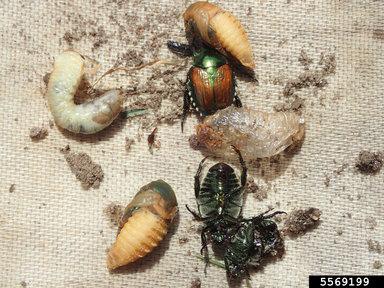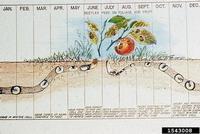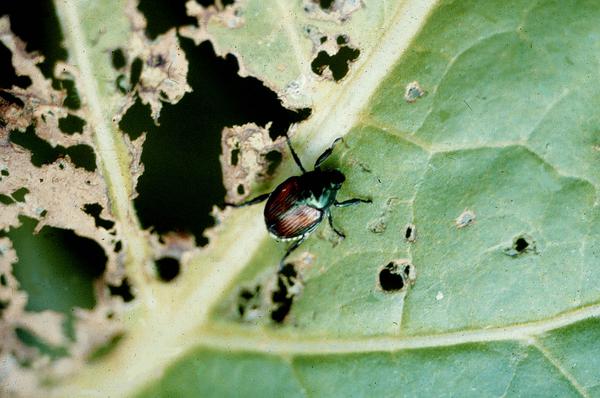Overview
Scientific Name(s)
Popillia japonica Newman
Damage Appearance
Holes or chewing damage
Field Distribution
Localized
Season
Pre-harvest, harvest
Cropping System
Feeds on multiple crop and non crop plants
Biology
The Japanese beetle (Popillia japonica Newman) is a moderately sized (approximately an inch long) scarab beetle with a bright metallic green in the head/thorax and copper wing covers1. Beetles also have six distinct pairs of white hair tufts along their abdomen that help distinguish it from other similar beetles. An adult Japanese beetle can feed on foliage, fruits and flowers of over 300 species of plants in at least 79 plant families2.
Adults males and females can be distinguished by the spine on the front tibia. In females, the spine is rounded and males it is sharper3. Japanese Beetles have one generation per year, and adult females lay 40-60 eggs in the soil that hatch into grubs about 10 days later4. The grubs feed until October and will remain inactive until spring (March / April) when they start to feed again. In the southeast, grubs will pupate in May with adults emerging in June, starting the process over.

Japanese beetle adult, pupae, and grubs.
Whitney Cranshaw, Colorado State University, Bugwood.org CC BY-NC 4.0
Damage in Industrial Hemp
Adult Japanese beetles chew holes that can eventually skeletonize the leaves by feeding on the tissue between the veins, leaving a lace-like appearance and can damage flowers. In large numbers, adults can completely defoliate plants. The grubs may cause damage to the roots in the ground prior to May and again in August and September just before harvest3, although they may prefer grass roots.
Sampling and Thresholds
Start monitoring for Japanese beetles in early June and visually inspect plants for injury.
As industrial hemp is a relatively new crop in North Carolina, no research has been done to determine the threshold for concern. Further investigation is needed since the hemp crop is grown for different markets (i.e. fiber, seed, CBD).
Management Options
Disclaimer: The following recommendations have been known to work in other plant systems, however, their effectiveness in hemp needs further investigation. We are developing a table for industrial hemp materials in the North Carolina Agricultural Chemicals Manual, but for the time being the Industrial Hemp portal is the best resource for up to date information. As laws and regulations are constantly changing in regards to hemp check with your local extension agent with any label or regulatory concerns.
Organic insecticides
Insecticides registered in hemp are limited. Some formulations of azadiractin, the active ingredient in neem oil, have been shown to have some activity against adult Japanese beetles, and some of the current federally registered pesticides contain azadiractin. Paenibacillus popilliae or milky spore disease may be effective against larvae in soil surrounding hemp fields but is not currently registered in hemp.
Biological Control
Two types of beneficial insects attack Japanese beetles. The parasitoid wasps Tiphia vernalis and Tiphia popilliavora attack Japanese beetle larvae, and parasitoid flies (Istocheta aldrichi) attack adult beetles3. All three of these insects were introduced in the US for Japanese beetle control and now occur naturally where Japanese beetle is established.
Citations
1. Japanese beetles in yards and gardens
2. Potter DA, Held DW. Biology and management of the Japanese beetle. Annu Rev Entomol. 2002;47(1):175-205. doi: 10.1146/annurev.ento.47.091201.145153.
3. Japanese Beetle Pest Management in Primocane-Bearing Raspberries
Support
The information in this factsheet was developed with support from the North Carolina Tobacco Trust Fund Commission.
Publication date: April 22, 2020
Recommendations for the use of agricultural chemicals are included in this publication as a convenience to the reader. The use of brand names and any mention or listing of commercial products or services in this publication does not imply endorsement by NC State University or N.C. A&T State University nor discrimination against similar products or services not mentioned. Individuals who use agricultural chemicals are responsible for ensuring that the intended use complies with current regulations and conforms to the product label. Be sure to obtain current information about usage regulations and examine a current product label before applying any chemical. For assistance, contact your local N.C. Cooperative Extension county center.
N.C. Cooperative Extension prohibits discrimination and harassment regardless of age, color, disability, family and marital status, gender identity, national origin, political beliefs, race, religion, sex (including pregnancy), sexual orientation and veteran status.


